AMD’s Jaguar Architecture: The CPU Powering Xbox One, PlayStation 4, Kabini & Temash
by Anand Lal Shimpi on May 23, 2013 12:00 AM ESTKabini: Mainstream APU for Notebooks
AMD will be building two APUs based on Jaguar: Kabini and Temash. Kabini is AMD’s mainstream APU, which you can expect to see in ultra-thin affordable notebooks. Note that both of these are full blown SoCs by conventional definitions - the IO hub is integrated into the monolithic die. Kabini ends up being the first quad-core x86 SoC if we go by that definition.
Kabini will carry A and E series branding, and will be available in a full quad-core version (A series) as well as dual-core (E series). The list of Kabini parts launching is below:
On the GPU side we have a 2 Compute Unit implementation of AMD’s Graphics Core Next architecture. The geometry engine has been culled a bit (1/4 primitive per clock) in order to make the transition into these smaller/low cost APUs. Double precision is supported at 1/16 rate, although adds and some muls will run at 1/8 the single precision rate.
Kabini features a single 64-bit DDR3 memory controller and ranges in TDPs from 9W to 25W. Although Jaguar supports dynamic frequency boosting (aka Turbo mode), the feature isn’t present/enabled on Kabini - all of the CPU clocks noted in the table above are the highest you’ll see regardless of core activity.
We have a separate review focusing on the performance of AMD’s A4-5000 Kabini APU live today as well.
Temash: Entry Level APU for Tablets
While Kabini will go into more traditional notebook designs, Temash will head down into the tablet space. The Temash TDPs range from 3.9W all the way up to 9W. Of the three Temash parts launching today, two are dual-core designs with the highest end A6-1450 boasting 4 cores as well as support for turbo core. The A6-1450’s turbo core implementation also enables TDP sharing between the CPU and GPU cores (idle CPUs can be power gated and their thermal budget given to the GPU, and vice versa).
The A4-1200 is quite interesting as it carries a sub-4W TDP, low enough to make it into an iPad-like form factor. It’s also important to note that AMD doesn’t actually reduce the number of GPU cores in any of the Temash designs, it just scales down clock speed.
Xbox One & PlayStation 4
In both our Xbox One and PS4 articles I referred to the SoCs as using two Jaguar compute units - now you can understand why. Both designs incorporate two quad-core Jaguar modules, each with their own shared 2MB L2 cache. Communication between the modules isn’t ideal, so we’ll likely see both consoles prefer that related tasks run on the same module.
Looking at Kabini, we have a good idea of the dynamic range for Jaguar on TSMC’s 28nm process: 1GHz - 2GHz. Right around 1.6GHz seems to be the sweet spot, as going to 2GHz requires a 66% increase in TDP.
The major change between AMD’s Temash/Kabini Jaguar implementations as what’s done in the consoles is really all of the unified memory addressing work and any coherency that’s supported on the platforms. Memory buses are obviously very different as well, but the CPU cores themselves are pretty much identical to what we’ve outlined here.


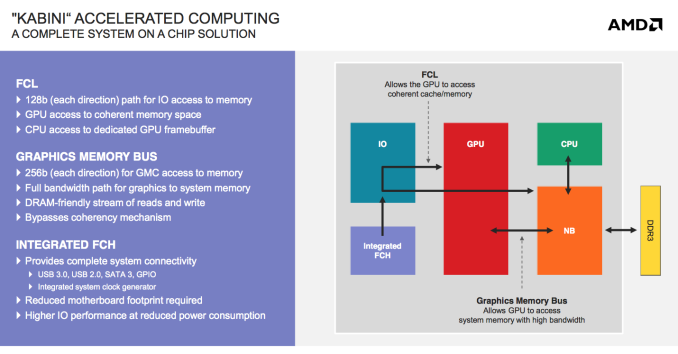
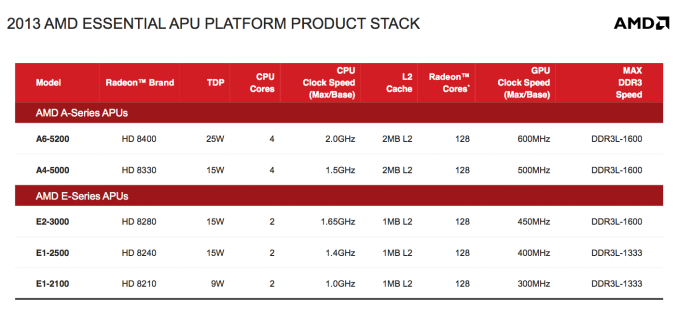


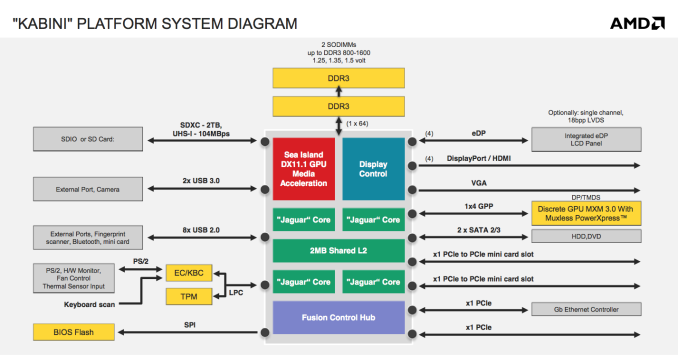
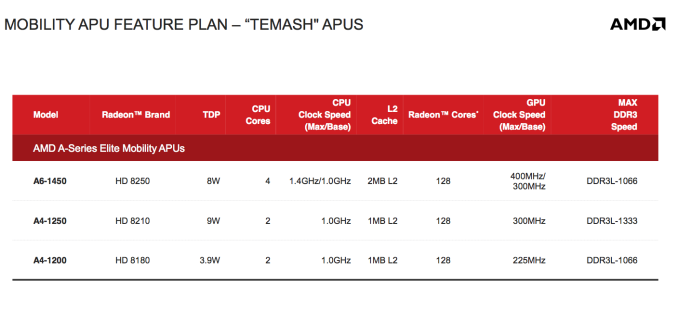
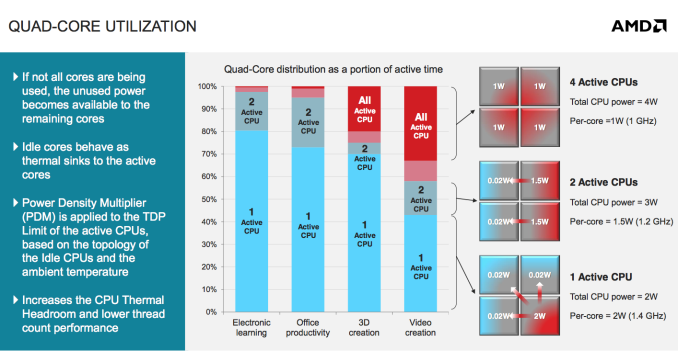








78 Comments
View All Comments
blacks329 - Thursday, May 23, 2013 - link
I know its definitely not that high for any individual platform, but I do remember a lot of major publishers, Ubi, EA and a bunch of other smaller studios had said (early-mid gen) that because porting to PS3 was such a nightmare and resource intensive, that it was more efficient to spend extra resources initially and use the PS3 as the lead and then have it ported over to 360, which was significantly easier.While I'm sure quite a large chunk still use 360's as their lead platform, I would say 90% was probably very early in this gen and since then has dropped to be much closer between 360 and PS3.
Although at this point both architectures are well understood and accounted for that most engines should make it easier to develop for both regardless of what platform is started with.
mr_tawan - Sunday, May 26, 2013 - link
I don't think using x86 would benefit the dev as much as many expected. Sure using the same hw-level arch may simplify the low-level code like asm, but seriously, I don't many of devs nowaday uses asm intensively anymore. (I had been working for current-gen console titles for a little, and never write even a single line of asm). Current-gen of game is complex, and need the best software architecture, otherwise it would lead to delay-to-death shipping schedule. Using asm would lead to premature optimisation that gains little-to-nothing.What would really affect the dev heavily is sdk. XB1 uses custom OS, but the SDK should be closed to Windows' DirectX (just like XB360). PS4, if it's in the same fashion as PS3, would use the custom-made SDK with OpenGL/OpenGL ES API (PS3 uses OpenGL ES, if I'm not mistaken). It needs another layer of abstration to make it easier to make it fully cross-platform, just like the current generation.
The thing that might be shared across two platform might be the shader code, if AMD can convince both MS and Sony to use the same language.
That's only guesses, I might be wrong.
mganai - Thursday, May 23, 2013 - link
That, and Intel's been making a bigger push for the smartphone market; it even says so in the article!Silvermont should change things up quite favorably.
mschira - Thursday, May 23, 2013 - link
Well all this is pointless if nobody makes good hardware using it.It's the old story. The last generation Trinity would have allowed very decent mid range notebooks with very long battery run time and more than sufficient power at reasonably low costs.
Have we seen anything?
Nope.
So where is a nice 11" Trinity Laptop?
Or a 10" Brazos?
All either horrible cheap Atom or expensive ULV core anything.
Are the hardware makers afraid that AMD can deliver enough chips?
Are they worried stepping on Intels toes?
Are they simply uncreative all running in the same direction some stupid mainstream guide tell them?
I suspect it is largely the latter - and most current notebooks are simply uncreative. The loss of sales comes to no surprise I think. And its not all M$ fault.
M.
Mathos - Thursday, May 23, 2013 - link
It could be another instance of Intel paying oems to not use certain AMD parts. They've done it before, wouldn't be surprised if it happens again in area's where AMD might have a better component.But it's also not totally true, having worked at Wal-Mart and other big chain stores, I can tell you that many do carry laptops and ultrathins that use Trinity A series chips, and Brazos E series chips. But, right now, everyone still wants that ipad or galaxy tab. And in general the only people I saw buying laptops and ultrathins were the people during the back to school or back to college crowds. And of course black Friday hordes.
And with AMD having both next gen consoles under their belt, them and many OEMs may be able to leverage that to draw sales of jaguar based systems.
Gest - Saturday, May 25, 2013 - link
So does Jaguar have new (any) hardware instructions that intel processors don't? (Will intel add them in haswell?) I think game makers will use them actively during the consoles lifetime.scaramoosh - Monday, May 27, 2013 - link
Doesn't this just mean the console CPU power is lacking compared to what PCs currently have?Silma - Wednesday, May 29, 2013 - link
Absolutely.